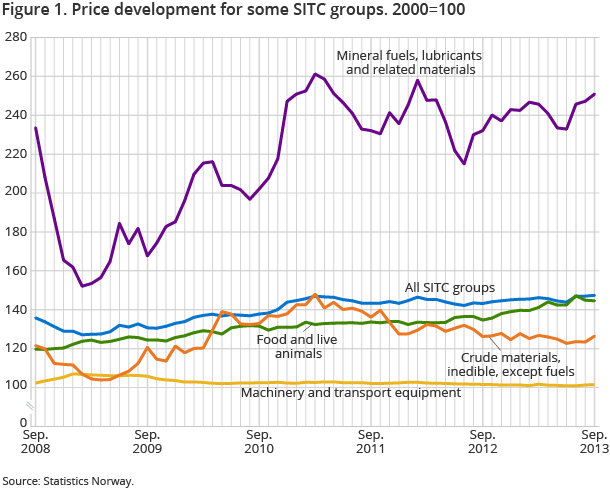Content
Published:
This is an archived release.
Price rise in energy products
The price index of first-hand domestic sales (PIF) rose by 0.3 per cent from August to September 2013. The increase was due to higher prices within mineral fuels, lubricants and related materials, as well as increasing prices of crude materials. Compared with September 2012, the PIF was 2.9 per cent higher in September this year.
| Per cent | Per cent | Index | Weights1 | |
|---|---|---|---|---|
| September 2013 / August 2013 | September 2013 / September 2012 | September 2013 | ||
| 1The weights are updated annually, and are valid for the entire year. | ||||
| Product groups | ||||
| Total index | 0.3 | 2.9 | 147.4 | 1 000.0 |
| Food | -0.2 | 7.3 | 144.6 | 177.1 |
| Beverages and tobacco | 0.2 | 6.2 | 153.3 | 14.3 |
| Crude materials, inedible, except fuels | 2.4 | 0.2 | 126.4 | 52.5 |
| Mineral fuels, lubricants and related materials | 1.5 | 8.1 | 250.9 | 231.0 |
| Chemicals and related products, n.e.s. | -1.4 | 2.5 | 143.3 | 71.2 |
| Manufactured goods classified by material | -0.2 | -1.8 | 128.6 | 131.3 |
| Machinery and transport equipment | 0.2 | -0.1 | 101.5 | 231.9 |
| Miscellaneous manufactured articles | 0.0 | 0.6 | 112.2 | 84.6 |

Prices within mineral fuels, lubricants and related materials rose by 1.5 per cent from August to September. Prices of both natural gas and electricity increased during the period. Electricity prices rose by 5.5 per cent, and one of the reasons for this can be lower precipitation in September than normal for this time of the year. Another important contribution to the rise in the overall index stemmed from crude materials, inedible, except fuels. Within this group, metalliferous ores and metal scrap had the strongest price increase. Other product groups with increasing prices in September were machinery and transport equipment, as well as beverages and tobacco.
One of the product groups with falling prices from August to September was chemicals. Prices in this group dropped by 1.4 per cent, mainly due to a price decrease within inorganic chemicals. Within food products, fish prices had the strongest influence on bringing the food index down. Manufactured goods had a modest price decrease in September.
Higher import prices for fruit and vegetables
Prices in some product groups changed in the opposite directions in the two markets from August to September. As an example, prices of food products fell in the domestic market, while prices for imported food rose in the same period. The reason behind the price increase within imported goods was fruit and vegetables, and this was most likely caused by seasonal variations. Fish, which has more weight in the domestic market than the import market, brought the price of Norwegian produced food down.
Twelve-month change: prices up 2.9 per cent
The PIF rose by 2.9 per cent from September 2012 to September 2013. Prices of mineral fuels, lubricants and related materials rose by 8.1 per cent, mainly due to a 40 per cent rise in prices of electricity. Other commodity groups with increasing prices were food and chemicals.
Prices fell within manufactured goods, down 1.8 per cent over the last twelve months. The price decrease was mainly driven by lower prices of non-ferrous metals. Price also fell within machinery and transport equipment, as well as within animal and vegetable oils.
The strongest price rise over the last twelve months stemmed from goods produced and sold in the Norwegian market.
Additional information
Contact
-
Producer price index
E-mail: produsentpris@ssb.no
tel.: (+47) 21 09 40 00
-
Elisabeth Mælum
E-mail: elisabeth.maelum@ssb.no
tel.: (+47) 97 01 28 49
-
Monika Græsli Engebretsen
E-mail: monika.graesli.engebretsen@ssb.no
tel.: (+47) 40 90 23 71
-
Morten Madshus
E-mail: morten.madshus@ssb.no
tel.: (+47) 40 90 26 94
